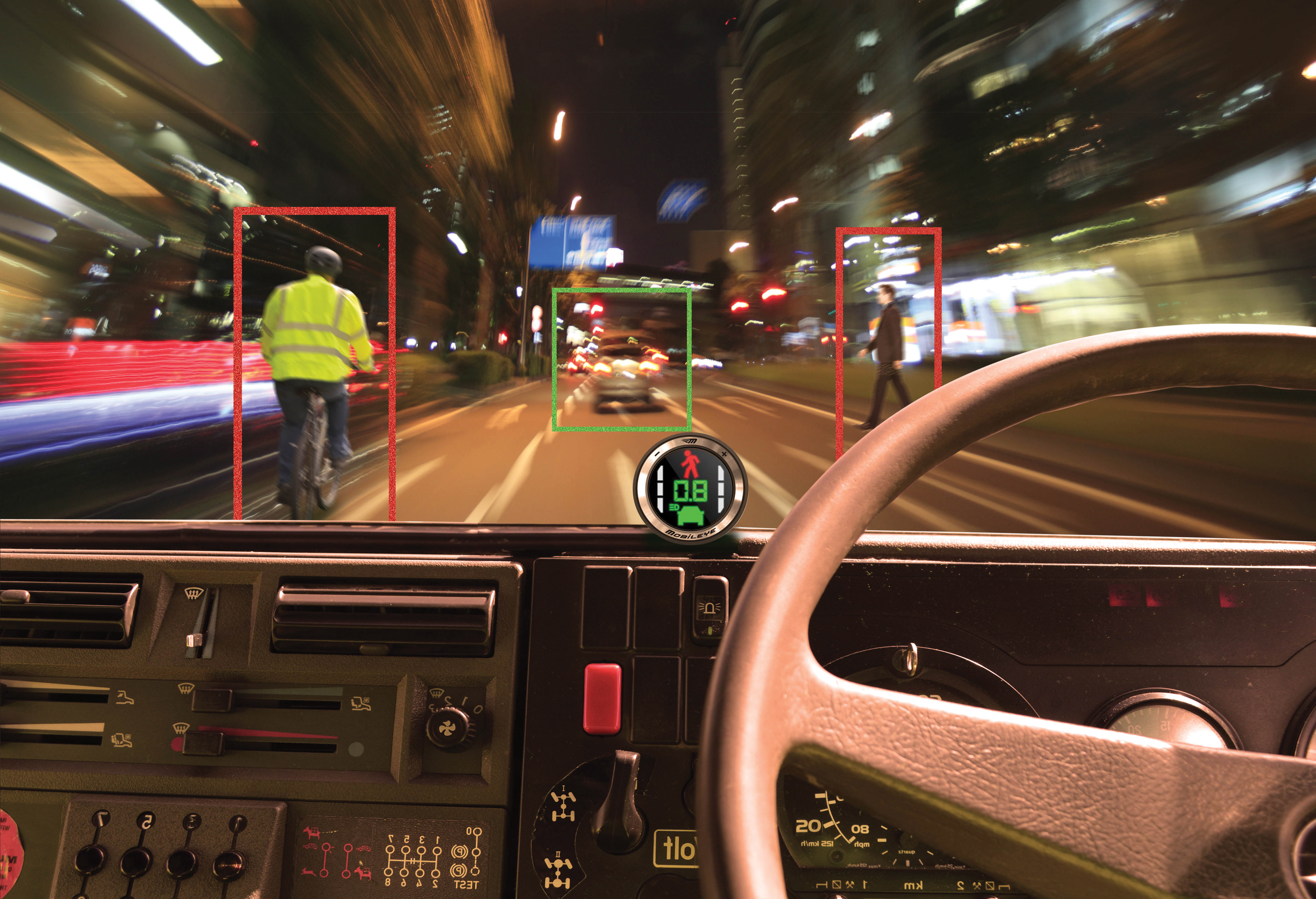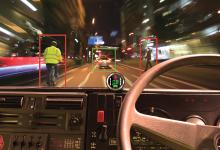New systems in development for protecting vulnerable road users - Mike Woof writes In many European countries the number of people using bicycles for commuting are increasing. This is being actively encouraged by city authorities as it offers an effective way to reduce traffic congestion, lower exhaust emissions and also improve public health. The Netherlands and Denmark have long had high percentages of commuters opting to use bicycles and other European countries are looking to capitalise on the experienc

An array of measures can help motorists identify vulnerable road users even in low light conditions
New systems in development for protecting vulnerable road users - Mike Woof writes
In many European countries the number of people using bicycles for commuting are increasing. This is being actively encouraged by city authorities as it offers an effective way to reduce traffic congestion, lower exhaust emissions and also improve public health. The Netherlands and Denmark have long had high percentages of commuters opting to use bicycles and other European countries are looking to capitalise on the experience of these countries, particularly in regard to the cities of Amsterdam and Copenhagen.
The developed nations of the west have long since recognised that inactivity poses a major threat to human health, while vehicle numbers in major cities have resulted in massive congestion at peak periods as well as serious pollution problems. Shifting a percentage of the shorter journeys to cycle traffic clearly offers a solution. But safety for vulnerable road users presents a concern. With this in mind, the International Transport Forum (ITF) has created a working group focussing on Cycling Safety, which has set up a programme: titled Cycling Safety: Key Messages.
This programme highlights the issue that a safety challenge to cycling comes from road systems having largely been designed for motor traffic rather than bicycles. Few roads in Europe have been designed for mixing well-protected, heavy and high velocity vehicles with unprotected, lightweight and slower road users. Nor do Europe’s traffic systems account for the specific characteristics of cyclists and bicycles. Cyclist behaviour can be unpredictable to non-cycling drivers while riders display different abilities and also try to minimise energy expenditure by only braking when necessary. In addition, bicycles can be easily destabilised and can be difficult to see because of their small profile, even in daytime, and their poor - or lack of - night-time lighting. Though cycling is an important component of urban mobility, cyclists are often regarded as intruders in the road system, particularly by many drivers who fail to understand that far from slowing motor vehicle transport, increased cycling cuts congestion and reduces journey times for all road users.
The ITF recognises that cycling is a moderate form of exercise and can greatly reduce clinical health risks linked to cardiovascular disease, obesity, Type-2 diabetes, certain forms of cancer, osteoporosis and depression. These present enormous costs to western society, which most governments are keen to tackle. This health-improving effect has been widely seen across various studies and in different geographic contexts, and there is evidence from research that the health benefits of cycling vastly outweigh the risks by a factor of around 20:1.
In the UK, the Transport Research Laboratory (TRL) is carrying out a €4.77 million (£4 million) test programme for Transport for London (TfL). This project is investigating how Dutch-style cycling infrastructure, such as segregated lanes and cyclist-priority roundabouts, could be adapted for UK road conditions. London and Bristol are two of the cities looking to replicate some of the benefits of cycle commuting seen in Amsterdam and Copenhagen in particular, as well as other European cities such as Munich and Berlin.
Work is already underway in London to improve some key roads and junctions, forming part of a €1.07 billion (£900 million) plan to make the UK’s heavily congested capital more cycle friendly. One novel concept is a system that places bus stops out of cycle lanes, another is a cycle lane featuring reflective humps rather than a kerb, and a Dutch-style roundabout with a segregated gyratory flow for bikes. This last presents a challenge for drivers, who have to learn that the circular flow of cyclists has priority, not only over vehicles joining the system, but those turning to exit. The Dutch-style roundabouts also face challenges with regard to traffic volumes however as they are designed for lower traffic levels than the 50,000 vehicles/day seen on some roads in parts of London. It is clear that these can only be placed in areas where motor traffic levels are lower, or where measures are being taken to control vehicle numbers.
Changes in vehicle use however are being seen in developed nations in Europe as well as North America. Motor vehicle use has declined amongst younger people, with cycling becoming more fashionable. This is particularly evident in Europe, where fuel costs are high and where young drivers pay enormously high insurance rates for cars, resulting in an increasing proportion not owning cars and in many instances, not even learning to drive. While motor vehicle numbers are still projected to increase in Europe, the cost of constructing additional infrastructure is now beyond the capacity of many nations. Controlling motor traffic volumes is a key priority and increasing the percentage of cycle commuting offers an important tool.
Safety concerns do remain though and some novel technologies have been developed to improve safety for cyclists. The Cycle Safety Shield System is now being made available in the UK and has gone through considerable development, having originally been designed to work with radio-frequency identification tags (RFID tags), fitted to each cycle. This technology can be fitted to any vehicle, such as buses, HGVs and taxis and will alert the driver when any cyclist with a RFID tag fitted approaches a danger zone. This concept originated from a product used on construction projects, with machine operators alerted being to the presence of site personnel who carry RFID tags. Although this technology works, it relies on users carrying RFID tags, simple on a construction site but markedly less so for cycle commuters.
There was strong concern that distributing tags to all cyclists in a major city such as London would be impossible. This would result in any untagged cyclist facing an even higher risk, as drivers relying on the technology would not be alerted to the presence of an untagged road user.
More development was needed and a solution was found. This second generation system uses the Mobileye EYEQ2 chip and is designed for HGVs to cover blind spots and danger zones, a key issue given that HGVs are involved in a worryingly high proportion of fatal incidents with cyclists. This version of the Cycle Safety Shield is an Advanced Driving Assistance System (ADAS) with a warning scheme. Its primary function is to prevent collisions with pedestrians, cyclists and motorcycles while it will not detect other objects such as other motorists or street furniture.
A key requirement for an improved safety culture is also better driver training and awareness. Cycle Safety Shield delivers part of this through its warning and anti-collision detection with its cyclist and pedestrian detection, vehicle collision avoidance and lane departure warning. It also offers traffic sign recognition including speeding warning, headlamp control and fleet management tools giving detailed data of driver behaviour.
The system complements the training now being delivered to HGV drivers and works well alongside existing HGV safety systems.
In many European countries the number of people using bicycles for commuting are increasing. This is being actively encouraged by city authorities as it offers an effective way to reduce traffic congestion, lower exhaust emissions and also improve public health. The Netherlands and Denmark have long had high percentages of commuters opting to use bicycles and other European countries are looking to capitalise on the experience of these countries, particularly in regard to the cities of Amsterdam and Copenhagen.
The developed nations of the west have long since recognised that inactivity poses a major threat to human health, while vehicle numbers in major cities have resulted in massive congestion at peak periods as well as serious pollution problems. Shifting a percentage of the shorter journeys to cycle traffic clearly offers a solution. But safety for vulnerable road users presents a concern. With this in mind, the International Transport Forum (ITF) has created a working group focussing on Cycling Safety, which has set up a programme: titled Cycling Safety: Key Messages.
This programme highlights the issue that a safety challenge to cycling comes from road systems having largely been designed for motor traffic rather than bicycles. Few roads in Europe have been designed for mixing well-protected, heavy and high velocity vehicles with unprotected, lightweight and slower road users. Nor do Europe’s traffic systems account for the specific characteristics of cyclists and bicycles. Cyclist behaviour can be unpredictable to non-cycling drivers while riders display different abilities and also try to minimise energy expenditure by only braking when necessary. In addition, bicycles can be easily destabilised and can be difficult to see because of their small profile, even in daytime, and their poor - or lack of - night-time lighting. Though cycling is an important component of urban mobility, cyclists are often regarded as intruders in the road system, particularly by many drivers who fail to understand that far from slowing motor vehicle transport, increased cycling cuts congestion and reduces journey times for all road users.
The ITF recognises that cycling is a moderate form of exercise and can greatly reduce clinical health risks linked to cardiovascular disease, obesity, Type-2 diabetes, certain forms of cancer, osteoporosis and depression. These present enormous costs to western society, which most governments are keen to tackle. This health-improving effect has been widely seen across various studies and in different geographic contexts, and there is evidence from research that the health benefits of cycling vastly outweigh the risks by a factor of around 20:1.
In the UK, the Transport Research Laboratory (TRL) is carrying out a €4.77 million (£4 million) test programme for Transport for London (TfL). This project is investigating how Dutch-style cycling infrastructure, such as segregated lanes and cyclist-priority roundabouts, could be adapted for UK road conditions. London and Bristol are two of the cities looking to replicate some of the benefits of cycle commuting seen in Amsterdam and Copenhagen in particular, as well as other European cities such as Munich and Berlin.
Work is already underway in London to improve some key roads and junctions, forming part of a €1.07 billion (£900 million) plan to make the UK’s heavily congested capital more cycle friendly. One novel concept is a system that places bus stops out of cycle lanes, another is a cycle lane featuring reflective humps rather than a kerb, and a Dutch-style roundabout with a segregated gyratory flow for bikes. This last presents a challenge for drivers, who have to learn that the circular flow of cyclists has priority, not only over vehicles joining the system, but those turning to exit. The Dutch-style roundabouts also face challenges with regard to traffic volumes however as they are designed for lower traffic levels than the 50,000 vehicles/day seen on some roads in parts of London. It is clear that these can only be placed in areas where motor traffic levels are lower, or where measures are being taken to control vehicle numbers.
Changes in vehicle use however are being seen in developed nations in Europe as well as North America. Motor vehicle use has declined amongst younger people, with cycling becoming more fashionable. This is particularly evident in Europe, where fuel costs are high and where young drivers pay enormously high insurance rates for cars, resulting in an increasing proportion not owning cars and in many instances, not even learning to drive. While motor vehicle numbers are still projected to increase in Europe, the cost of constructing additional infrastructure is now beyond the capacity of many nations. Controlling motor traffic volumes is a key priority and increasing the percentage of cycle commuting offers an important tool.
Safety concerns do remain though and some novel technologies have been developed to improve safety for cyclists. The Cycle Safety Shield System is now being made available in the UK and has gone through considerable development, having originally been designed to work with radio-frequency identification tags (RFID tags), fitted to each cycle. This technology can be fitted to any vehicle, such as buses, HGVs and taxis and will alert the driver when any cyclist with a RFID tag fitted approaches a danger zone. This concept originated from a product used on construction projects, with machine operators alerted being to the presence of site personnel who carry RFID tags. Although this technology works, it relies on users carrying RFID tags, simple on a construction site but markedly less so for cycle commuters.
There was strong concern that distributing tags to all cyclists in a major city such as London would be impossible. This would result in any untagged cyclist facing an even higher risk, as drivers relying on the technology would not be alerted to the presence of an untagged road user.
More development was needed and a solution was found. This second generation system uses the Mobileye EYEQ2 chip and is designed for HGVs to cover blind spots and danger zones, a key issue given that HGVs are involved in a worryingly high proportion of fatal incidents with cyclists. This version of the Cycle Safety Shield is an Advanced Driving Assistance System (ADAS) with a warning scheme. Its primary function is to prevent collisions with pedestrians, cyclists and motorcycles while it will not detect other objects such as other motorists or street furniture.
A key requirement for an improved safety culture is also better driver training and awareness. Cycle Safety Shield delivers part of this through its warning and anti-collision detection with its cyclist and pedestrian detection, vehicle collision avoidance and lane departure warning. It also offers traffic sign recognition including speeding warning, headlamp control and fleet management tools giving detailed data of driver behaviour.
The system complements the training now being delivered to HGV drivers and works well alongside existing HGV safety systems.







